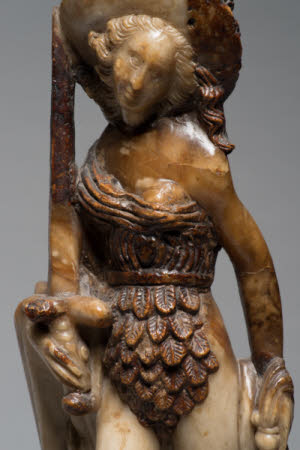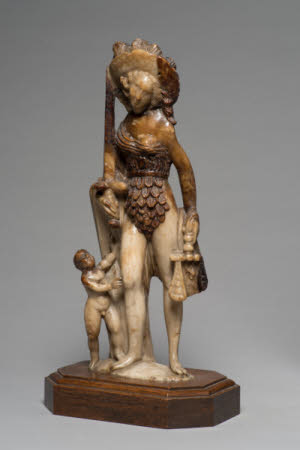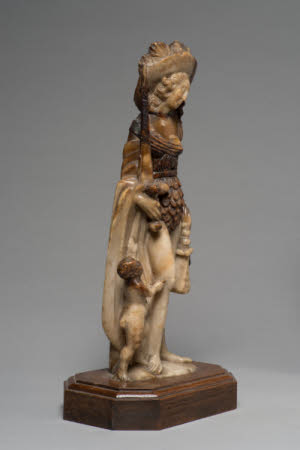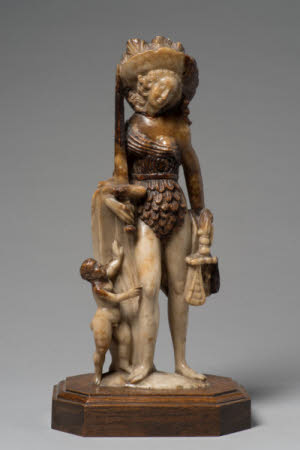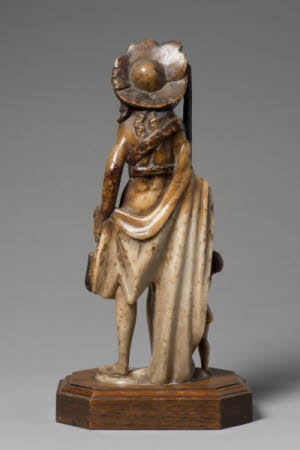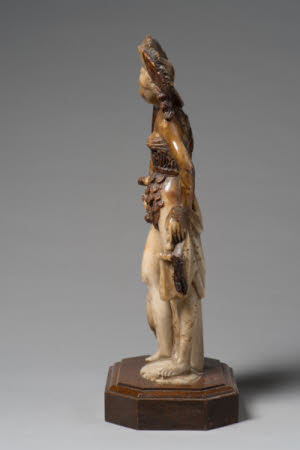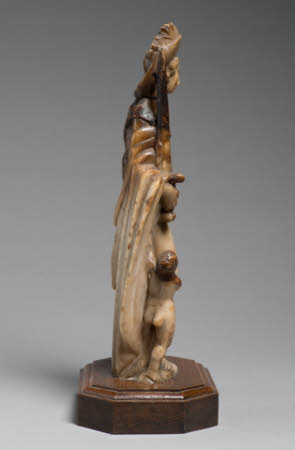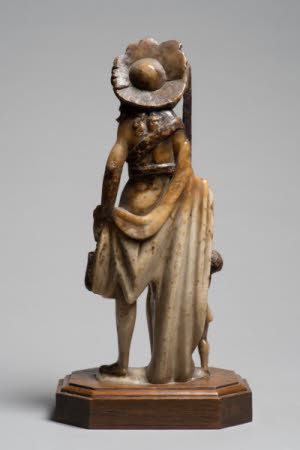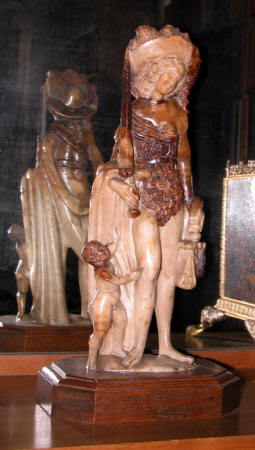Justice
Sicilian (Trapanese) School
Category
Art / Sculpture
Date
c. 1650 - 1700
Materials
Alabaster
Measurements
372 x 162 x 73 mm
Place of origin
Trapani
Order this imageCollection
Anglesey Abbey, Cambridgeshire
NT 516591
Summary
Alabaster, allegory of Justice, Sicilian (Trapanese) School, c. 1650-1700. An alabaster figure of Justice, made in Trapani in Sicily, in the period c. 1650-1700. Justice is depicted as a young woman holding a sword in her right and a pair of scales in the left. She wears a bizarre short tunic, the lower half made from feathers, the upper part some form of ribbed material, and a heart-shaped medallion in the centre, her left breast half-uncovered. A cloak, gathered in her right hand, passes behind her back and the end is held in her left hand. On her head a wide-brimmed hat, from underneath which spill long flowing tresses, at the sides and behind. At the left stands a naked boy who reaches up towards the woman. Both figures are set on an integral oval base, now on a later octagonal oak mount. The head of the woman broken and repaired. The right edge of the hat is probably a replacement. End of drapery in left hand is broken off.
Full description
One of the four Cardinal Virtues, Justice is a common allegorical figure in art. From the medieval period onwards, she was usually depicted as a female who holds a sword in one hand, representing the power to inflict punishment and, in the other, a pair of scales, symbolising the requirement in true justice to weigh fairly the arguments of all sides. Given the allegory’s association with government and the law, Justice is almost always a grave and modest figure. Her depiction in this alabaster statuette as the sort of young woman who would more commonly be found in erotic images of licence is astonishing, although not entirely without precedent, with occasional depictions in later sixteenth-century Germany of a more daring figure. The print-maker Jost Amman made a woodcut of Justice for his 1578 publication Enchiridion Artis, showing her as an attractive and scantily-clad seated woman, with luxuriant hair and breasts visible through her dress (Gero Seelig, The New Hollstein. German Engravings, Etchings and Woodcuts. Jost Amman, Book Illustrations, Part VI, Rotterdam 2003, p. 27, no. 134.65 (2068)). The Augsburg silversmith Paul Hübner (master 1583, died 1614) adapted another woodcut by Amman of a young woman on horseback to create a daring figure of Justice on a silver-gilt tazza, one of a set of twelve dishes featuring the Virtues and the Elements in the Waddesdon Bequest at the British Museum. Here Justice has her back to the spectator, with a shapely leg projecting forward. She likewise is flimsily dressed (Inv. WB.97.D. Hugh Tait, Catalogue of the Waddesdon Bequest in the British Museum. II. The Silver Plate, London 1988, pp. 170-72, no. 27). A century later she could still sometimes be depicted as a young attractive woman, for example in Luca Giordano’s fresco for the Palazzo Medici Riccardi in Florence, painted in the 1680s (modello in the National Gallery, London, NG 6633), in which she is shown with her breasts bared. Although these images provide a context, her apparel in the Anglesey Abbey Justice (more akin to a modern swimsuit!) seems to be without parallel. The presence of a young boy (putto), with its echoes of Cupid, adds to the resonance of the figure with depictions of Venus, the goddess of love. The figure is one of a series of similar allegorical figures made in Trapani in Sicily, a city best known for its carvings in coral. Trapani was also however home to a flourishing school of sculpture in alabaster from the 16th century, which used a characteristic locally-mined form of red-veined stone known as alabastro rosa or pietra incarnata. The Jesuit Guglielmo Gumppenberg recorded in 1672 that there were around forty workshops in Trapani, in which the principal occupation was the production every year of around 5,000 small images of the Madonna of Trapani, mostly in alabaster (an example at Anglesey Abbey, NT 516604), but also in coral, the material for which Trapani is best known (Guilielmus Gumppenberg, Atlas Marianus, Munich 1672, p. 120). There is an important group of Trapani sculptures at Anglesey Abbey. As well as the Justice and the Virgin and Child, there is a magnificent figure of Saint Sebastian (NT 516597) and an unusual treatment of the Nativity (NT 516581). Jeremy Warren 2020
Provenance
Bequeathed to the National Trust by Huttleston Rogers Broughton, 1st Lord Fairhaven (1896-1966) with the house and the rest of the contents.
Credit line
Anglesey Abbey, The Fairhaven Collection (The National Trust)
Makers and roles
Sicilian (Trapanese) School, sculptor
References
Christie, Manson & Woods 1971: The National Trust, Anglesey Abbey, Cambridge. Inventory: Furniture, Textiles, Porcelain, Bronzes, Sculpture and Garden Ornaments’, 1971, p. 140, Silver Strong Room. Warren 2021: Jeremy Warren, ‘New perspectives on alabaster sculpture from Trapani‘, Colnaghi Studies Journal, Vol. 8 (March 2021), pp. 115-47
